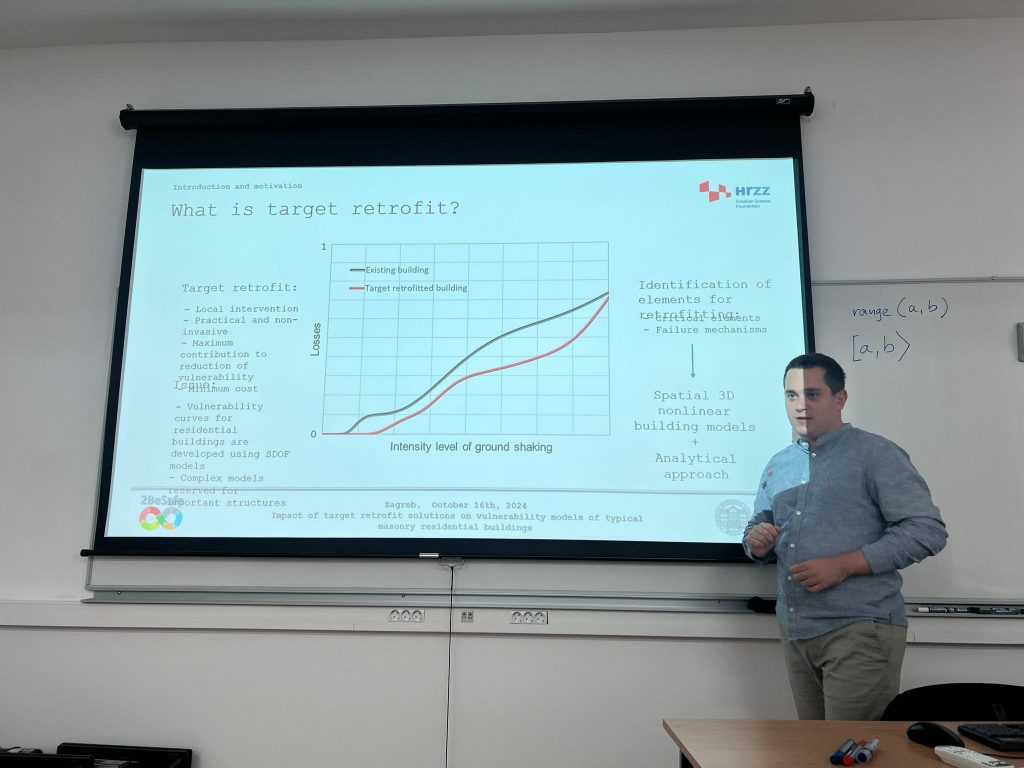
On September 16th, 2024 PhD candidate Ante Pilipović, employed at the 2BESAFE project, defended his PhD topic proposal titled “Impact of target retrofit solutions on vulnerability models of typical masonry residential buildings.” The PhD topic defense took place at location Sveti Duh of the Faculty of Civil Engineering, University of Zagreb and started at 2 p.m. The presentation of the topic lasted 30 minutes, and a discussion followed for another 30 minutes. The topic proposal defense lasted 1 hour in total.
The proposed PhD topic was inspired by the main goals of the 2BESAFE project, namely the development of new vulnerability models for typical buildings in urban areas, but also the development of a new methodology of target retrofitting and applications in seismic risk assessment. Target retrofitting aims to identify critical elements and failure mechanisms for a given building and retrofit only those critical elements that contribute the most to the development of the main failure mechanism, in order to achieve maximum increase in safety at minimum cost and with minimum intervention. The proposed research strives to develop new vulnerability models for the as-built and target retrofitted common building typologies, and determine the impact of target retrofit on single building and urban scale seismic risk assessment in terms of common risk metrics such as loss curves and average annual losses. Quantifying this impact may contribute to more reliable decision making when developing retrofitting campaigns, both pre and post-earthquake, for single buildings, but also for portfolios of common residential buildings in urban areas.
The research goals and hypotheses proposed are as follows:
Research goals:
1. Propose a new methodology for the development of high-fidelity fragility and vulnerability models for typical residential buildings in urban areas for use in seismic risk calculations.
2. Develop a new fragility and vulnerability model for a typical regional masonry pre-code residential building typology, both for the existing and target retrofitted building, and validate the model through a case study.
3. Identify critical elements and failure mechanisms of the selected building typology to determine optimal target retrofit solutions.
4. Determine the impact of target retrofit solutions on vulnerability curves and relevant risk metrics.
5. Determine the optimal intensity measure for characterizing ground motion for the selected building typology.
Hypotheses:
1. By using advanced numerical modelling approaches, it is possible to identify critical elements and failure mechanisms of common residential building typologies and develop target retrofit solutions that improve the global seismic performance of the building.
2. The impact of target retrofit solutions on the reduction of losses can be quantitatively measured by using loss curves and average annual losses.
The research plan is divided into 6 stages:
Stage 1: Overview of the state-of-the-art in seismic retrofitting and vulnerability assessment
Stage 2: Numerical modelling and analysis of a regional residential masonry building typology
Stage 3: Optimal target retrofit solution for the selected building
Stage 4: Development of new vulnerability models for the original and retrofitted building
Stage 5: Assessment of impact of target retrofit solutions on vulnerability of the building
Stage 6: Conclusions and implementation recommendations
The expected scientific contributions are:
1. New and more accurate fragility and vulnerability models for a common regional masonry building typology for use in seismic risk assessment calculations.
2. New risk-based method of evaluating the impact of retrofitting solutions for effective decision making by using loss curves and average annual losses as risk metrics.
3. New criteria developed for aggregating damage from local element damage to global damage states for the selected building typology.
After a fruitful discussion, the topic proposal was evaluated as feasible and in line with current research in the areas of seismic retrofitting, seismic risk assessment, and analytical vulnerability modelling. It is also in line with the main goals of the 2BESAFE project from which it was inspired, as it contributes to the methodology of the project, a model approach after which new vulnerability models for other typical buildings in urban areas will be developed.
We wish Ante success with further development of the proposed PhD topic and writing his dissertation.
